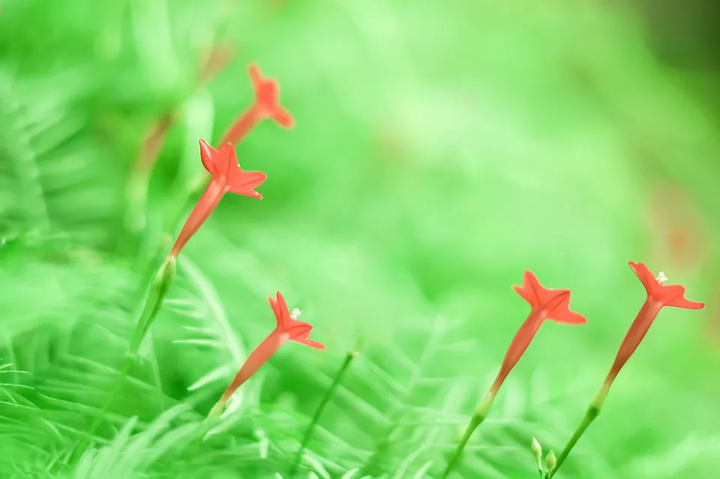Cypress vine belongs to the bindweed family (Convolvulaceae). It is valued not only as a flowering vine with star-shaped blooms but also as a foliage plant with graceful, fern-like leaves. When it comes to gardening with wildlife in mind, it hits the trifecta: Deer tend not to eat it, yet hummingbirds love it and it draws butterflies.

Botanical Name:
Ipomoea quamoclit
Common Name:
Cypress vine, red cypress vine, indian pink, star glory
Plant Type:
Annual vine
Mature Size:
6 to 15 feet in length, with a spread of three to 6 feet
Sun Exposure:
Full sun
Soil Type:
Fertile, well-drained, and kept evenly moist
Soil pH:
Neutral to slightly acidic or slightly alkaline
Bloom Time:
June to October
Flower Color:
Red; less commonly, pink or white
Hardiness Zones:
11 to 12
Native Area:
Tropical America
How to Grow Cypress Vine
Once you have decided on an outdoor location for them, your next step will generally be to provide a supporting structure for them to grow on. Cypress vine is a true climber that climbs by twining around objects. But be careful in handling the plant when you are moving it this way or that to encourage it to climb in a particular direction because this vine is delicate and easily damaged. Suitable supporting structures can include:
Arbors
Pergolas
Deck posts exposed to the sun
Lattice
Chain-link fencing
By growing cypress vines up a chain-link fence, you kill two birds with one stone, disguising the unsightly nature of the fence, while achieving privacy for part of the summer.
In the South, cypress vine may naturalize. If you wish to prevent this, deadhead the flowers so as to prevent seed production.
Light
Cypress vine needs full sun. Giving it proper support to climb on (so that it is not shaded by nearby plants) is often a necessary step in meeting this requirement.
Soil
Of the three recommendations for soil conditions (fertile, well-drained, and evenly moist), well-drained is the most critical. Cypress vine, once established, is reasonably tolerant of drought and can often get by without much fertilizing. But a soil that does not drain well will do it in every time.
Water
For ideal growth, water so as to keep the soil evenly moist (but not soggy).
Fertilizer
Cypress vine will grow bigger and more reliably if it is fed with a balanced fertilizer.
Potting
Cypress vine is grown from seed. While it is possible to sow the seeds directly outdoors (after danger of frost has passed), it can take a long time to get flowers from them in the North this way unless growing conditions are ideal. Many gardeners like to get a jump on the growing season by starting the plants indoors from seed in peat pots filled with potting mix, four to six weeks prior to the last frost date. Here's how:
Keep seeds moist for 24 hours before planting.
Lightly scar the surface of the seeds using sandpaper.
Plant the seeds 1/4 inch deep and cover them with the potting mix.
Keep the potting mix damp and warm (at least 70 F).
Germination will occur in 10 days.
Water the newly-germinated plants well to get them established.
Transplant the plants outside after all danger of frost has passed.
Toxicity of Cypress Vine
Like its better-known relative, the common morning glory (Ipomoea tricolor), cypress vine is a poisonous plant. For this reason, as tempting as it may be to grow it in a pot and install it in your patio landscaping, it is not a good plant to grow where young children will be present. For the same reason, make sure your pets don't eat it.
Comparison of Similar Plants
In addition to morning glory, other plants from the Ipomoea genus used in landscaping include:
Sweet potato vine (Ipomoea batatas)
Moonflower (Ipomoea alba)
Especially interesting is the relationship between cypress vine and cardinal climber (Ipomoea sloteri), a hybrid plant that offers similar features. Cypress vine is one of the parents of the latter, the other parent being red morning glory (Ipomoea coccinea). Confusingly, "cypress vine" is also sometimes used as a common name for Ipomoea sloteri and "cardinal climber" for Ipomoea quamoclit, which is why it is better to use the scientific names of plants when in doubt.